What Is a Piece of Art From the Shang Period
| Warring States period 戰國時代 | |
|---|---|
| c. 475–221 BC | |
 The Seven Warring States c. 260 BC |
| Warring States period | |||||||||||||||||||||||||||||||||||||||||
|---|---|---|---|---|---|---|---|---|---|---|---|---|---|---|---|---|---|---|---|---|---|---|---|---|---|---|---|---|---|---|---|---|---|---|---|---|---|---|---|---|---|
 "Warring States" in seal script (top), Traditional (middle), and Simplified (lesser) Chinese characters | |||||||||||||||||||||||||||||||||||||||||
| Traditional Chinese | 戰國時代 | ||||||||||||||||||||||||||||||||||||||||
| Simplified Chinese | 战国时代 | ||||||||||||||||||||||||||||||||||||||||
| Hanyu Pinyin | Zhànguó Shídài | ||||||||||||||||||||||||||||||||||||||||
| Literal significant | "Warring States era" | ||||||||||||||||||||||||||||||||||||||||
| |||||||||||||||||||||||||||||||||||||||||
| History of Communist china | |||
|---|---|---|---|
| ANCIENT | |||
| Neolithic c. 8500 – c. 2070 BC | |||
| Xia c. 2070 – c. 1600 BC | |||
| Shang c. 1600 – c. 1046 BC | |||
| Zhou c. 1046 – 256 BC | |||
| Western Zhou | |||
| Eastern Zhou | |||
| Jump and Autumn | |||
| Warring States | |||
| Regal | |||
| Qin 221–207 BC | |||
| Han 202 BC – 220 Advertisement | |||
| Western Han | |||
| Xin | |||
| Eastern Han | |||
| 3 Kingdoms 220–280 | |||
| Wei, Shu and Wu | |||
| Jin 266–420 | |||
| Western Jin | |||
| Eastern Jin | 16 Kingdoms | ||
| Northern and Southern dynasties 420–589 | |||
| Sui 581–618 | |||
| Tang 618–907 | |||
| 5 Dynasties and Ten Kingdoms 907–979 | Liao 916–1125 Western Xia 1038–1227 Jin 1115–1234 | ||
| Vocal 960–1279 | |||
| Northern Song | |||
| Southern Song | |||
| Yuan 1271–1368 | |||
| Ming 1368–1644 | |||
| Qing 1636–1912 | |||
| Modern | |||
| Republic of China on the mainland 1912–1949 | |||
| People's Republic of China 1949–nowadays | |||
| Republic of Cathay in Taiwan 1949–present | |||
| Related articles
| |||
The Warring States period (traditional Chinese: 戰國時代; simplified Chinese: 战国时代; pinyin: Zhànguó Shídài ) was an era in aboriginal Chinese history characterized past warfare, equally well equally bureaucratic and military reforms and consolidation. It followed the Spring and Autumn flow and ended with the Qin wars of conquest that saw the annexation of all other contender states, which ultimately led to the Qin land's victory in 221 BC as the first unified Chinese empire, known as the Qin dynasty.
Although different scholars point toward different dates ranging from 481 BC to 403 BC as the true commencement of the Warring States, Sima Qian's choice of 475 BC is the most often cited. The Warring States era also overlaps with the 2d one-half of the Eastern Zhou dynasty, though the Chinese sovereign, known as the king of Zhou, ruled merely equally a figurehead and served as a backdrop against the machinations of the warring states.
The "Warring States Period" derives its proper noun from the Tape of the Warring States, a work compiled early on in the Han dynasty.
Geography [edit]
The political geography of the era was dominated by the Seven Warring States, namely:
- Qin located in the far west, with its cadre in the Wei River Valley and Guanzhong. This geographical position offered protection from the other states simply limited its initial influence.
- The 3 Jins Located in the center on the Shanxi plateau were the three successor states of Jin. These were:
- Han south, along the Yellow River, controlling the approaches to Qin.
- Wei located in the center, roughly today's eastern Henan Province.
- Zhao the northernmost of the three, roughly today's southern Hebei Province as well as northern Shanxi Province.
- Qi east, centred on the Shandong Peninsula
- Chu southward, with its core territory effectually the valleys of the Han River and, later, the Yangtze River.
- Yan northeast, centred on modern-day Beijing. Belatedly in the period it pushed northeast and began to occupy the Liaodong Peninsula
Too these seven major states other smaller states survived into the period. They include:
- Royal territory of the Zhou king was nearly Luoyi in the Han expanse on the Yellowish River.
- Yue On the southeast coast well-nigh Shanghai was the State of Yue, which was highly active in the tardily Jump and Autumn era but was later annexed by Chu.
- Zhongshan Between us of Zhao and Yan was the state of Zhongshan, which was eventually annexed by Zhao in 296 BC.
- Sichuan states: In the far southwest were the non-Zhou states of Ba (east) and Shu (due west). These ancient kingdoms were conquered by Qin later in the period.
- Other minor states: In that location were many minor states which were satellites of the larger ones until they were captivated. Many were in the Central Plains between the three Jins (due west) and Qi (east) and Chu to the s. Some of the more than important ones were Song, Lu, Zheng, Wey, Teng, Yue and Zou.
Periodisation [edit]

The eastward flight of the Zhou court in 771 BC marks the start of the Bound and Autumn menstruation. No one single incident or starting point inaugurated the Warring States era. The political situation of the flow represented a culmination of historical trends of conquest and annexation which likewise characterised the Spring and Autumn flow; as a outcome there is some controversy every bit to the beginning of the era. Proposed starting points include:
- 481 BC
Proposed by Song-era historian Lü Zuqian, too known as Lü Bogong, since this yr marks the cease of the Spring and Fall Annals. - 476–475 BC
The writer, Sima Qian, of Records of the Grand Historian, chose this engagement as the countdown year of King Yuan of Zhou. - 453 BC
The Partition of Jin saw the dissolution/destruction of that key state of the before period and the formation of 3 of the 7 warring states: Han, Zhao, and Wei. - 441 BC
The countdown yr of Zhou Kings starting with King Ai of Zhou. - 403 BC
The year when the Zhou courtroom officially recognised Han, Zhao and Wei as states. Author Sima Guang of Zizhi Tongjian (published 1084) advocates this symbol of eroded Zhou dominance as the get-go of the Warring States era.
History [edit]
Background and formation [edit]

Map showing states at the beginning of Warring States period of Zhou Dynasty in Chinese history[ commendation needed ]
The Eastern Zhou Dynasty began to fall around 5th century BC. Equally their influence waned, they had to rely on other armies in other allied states rather than their own war machine forcefulness. Over 100 smaller states were made into 7 major states which included: Chu, Han, Qin, Wei, Yan, Qi and Zhao. However, there somewhen was a shift in alliances because each state's ruler wanted to be contained in power. This caused hundreds of wars between the periods of 535–286 BCE. The victorious state would have overall dominion and control in China.[1]
The system of feudal states created past the Western Zhou dynasty underwent enormous changes after 771 BC with the flying of the Zhou court to modern-twenty-four hours Luoyang and the diminution of its relevance and power. The Bound and Autumn period led to a few states gaining power at the expense of many others, the latter no longer able to depend on key potency for legitimacy or protection. During the Warring States menstruation, many rulers claimed the Mandate of Sky to justify their conquest of other states and spread their influence.[2]
The struggle for hegemony eventually created a state system dominated by several large states, such as Jin, Chu, Qin, Yan and Qi, while the smaller states of the Central Plains tended to be their satellites and tributaries. Other major states likewise existed, such equally Wu and Yue in the southeast. The final decades of the Spring and Autumn era were marked by increased stability, as the result of peace negotiations betwixt Jin and Chu which established their respective spheres of influence. This situation ended with the partition of Jin, whereby the state was divided between the houses of Han, Zhao and Wei, and thus enabled the creation of the seven major warring states.
Partitioning of Jin (453–403 BC) [edit]
The rulers of Jin had steadily lost political powers since the middle of the 6th century BC to their nominally subordinate nobles and military commanders, a situation arising from the traditions of the Jin which forbade the enfeoffment of relatives of the ducal business firm. This immune other clans to proceeds fiefs and armed services authority, and decades of internecine struggle led to the institution of four major families, the Han, Zhao, Wei and Zhi.
The Battle of Jinyang saw the allied Han, Zhao and Wei destroy the Zhi family (453 BC) and their lands were distributed amongst them. With this, they became the "de facto" rulers of most of Jin's territory, though this situation would non exist officially recognised until half a century later. The Jin sectionalization created a political vacuum that enabled during the first l years expansion of Chu and Yue northward and Qi southward. Qin increased its command of the local tribes and began its expansion southwest to Sichuan.
Early Warring States [edit]
The 3 Jins recognized (403–364 BC) [edit]

In 403 BC, the Zhou court under King Weilie officially recognized Zhao, Wei and Han every bit immediate vassals, thereby raising them to the same rank equally the other warring states.
From earlier 405 until 383 BC the iii Jins were united under the leadership of Wei and expanded in all directions. The most important figure was Marquess Wen of Wei (445–396 BC). In 408–406 BC he conquered the State of Zhongshan to the northeast on the other side of Zhao. At the same time he pushed west across the Yellow River to the Luo River taking the area of Xihe (literally 'west of the [Yellow] river').
The growing power of Wei caused Zhao to back away from the alliance. In 383 BC it moved its majuscule to Handan and attacked the small state of Wey. Wey appealed to Wei which attacked Zhao on the western side. Existence in danger, Zhao called in Chu. As usual, Chu used this as a pretext to addendum territory to its due north, simply the diversion immune Zhao to occupy a part of Wei. This disharmonize marked the end of the power of the united Jins and the kickoff a period of shifting alliances and wars on several fronts.
In 376 BC, the states of Han, Wei and Zhao deposed Knuckles Jing of Jin and divided the last remaining Jin territory between themselves, which marked the last terminate of the Jin country.
In 370 BC, Marquess Wu of Wei died without naming a successor, which led to a war of succession. After three years of civil state of war, Zhao from the n and Han from the south invaded Wei. On the verge of conquering Wei, the leaders of Zhao and Han barbarous into disagreement about what to do with Wei, and both armies abruptly retreated. Equally a event, Male monarch Hui of Wei (still a Marquess at the time) was able to ascend the throne of Wei.
By the end of the menstruum Zhao extended from the Shanxi plateau across the plain to the borders of Qi. Wei reached east to Qi, Lu and Song. To the southward, the weaker land of Han held the east-w part of the Yellow River valley, surrounded the Zhou royal domain at Luoyang and held an area north of Luoyang called Shangdang.
Qi resurgence under Tian (379–340 BC) [edit]
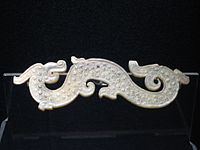
A carved-jade dragon garment ornament from the Warring States catamenia
Duke Kang of Qi died in 379 BC with no heir from the business firm of Jiang, which had ruled Qi since the state's founding. The throne instead passed to the future Male monarch Wei, from the firm of Tian. The Tian had been very influential at court towards the end of Jiang rule, and at present openly assumed ability.[3]
The new ruler fix nearly reclaiming territories that had been lost to other states. He launched a successful entrada against Zhao, Wey and Wei, once again extending Qi territory to the Great Wall. Sima Qian writes that the other states were so nonplussed that nobody dared assail Qi for more than 20 years. The demonstrated military prowess as well had a calming effect on Qi'southward own population, which experienced corking domestic repose during Wei's reign.[4]
By the end of King Wei'south reign, Qi had become the strongest of u.s.a. and proclaimed itself "king"; establishing independence from the Zhou dynasty (see below).
Wars of Wei [edit]
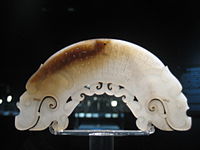
King Hui of Wei (370–319 BC) set nearly restoring the country. In 362–359 BC he exchanged territories with Han and Zhao in order to brand the boundaries of the three states more rational.
In 364 BC Wei was defeated by Qin at the Battle of Shimen and was only saved past the intervention of Zhao. Qin won another victory in 362 BC. In 361 BC the Wei capital letter was moved east to Daliang to be out of the reach of Qin.
In 354 BC, Male monarch Hui of Wei started a large-scale set on on Zhao. Past 353 BC, Zhao was losing badly and its capital, Handan, was under siege. The Country of Qi intervened. The famous Qi strategist, Sun Bin the great-swell-swell-grandson of Sun Tzu (author of the Art of War), proposed to assault the Wei capital letter while the Wei ground forces was tied up besieging Zhao. The strategy was a success; the Wei army hastily moved south to protect its uppercase, was caught on the road and decisively defeated at the Battle of Guiling. The battle is remembered in the 2nd of the Thirty-Six Stratagems, "besiege Wei, save Zhao" meaning to assail a vulnerable spot to salvage pressure level at another point.
Domestically, Male monarch Hui patronized philosophy and the arts, and is perhaps best remembered for hosting the Confucian philosopher Meng Zi at his court; their conversations form the first two capacity of the volume which bears Meng Zi'due south proper noun.
Dukes get kings [edit]
Qi and Wei become kings (344 BC) [edit]
The title of "king" (wang, 王 ) was held by figurehead rulers of the Zhou dynasty, while the rulers of almost states held the championship of "duke" (gong, 公 ) or "marquess" (hou, 侯 ). A major exception was Chu, whose rulers were chosen kings since King Wu of Chu started using the championship c. 703 BC.
In 344 BC the rulers of Qi and Wei mutually recognized each other as "kings": King Wei of Qi and King Hui of Wei, in upshot declaring their independence from the Zhou court. This marked a major turning point: unlike those in the Spring and Autumn period, the new generation of rulers ascending the thrones in the Warring States menstruum would not entertain even the pretence of existence vassals of the Zhou dynasty, instead proclaiming themselves fully contained kingdoms.
Shang Yang reforms Qin (356–338 BC) [edit]
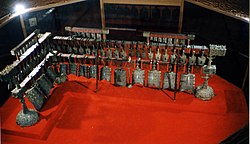
During the early Warring States flow Qin generally avoided conflicts with the other states. This changed during the reign of Duke Xiao, when prime minister Shang Yang made centralizing and disciplinarian reforms in accordance with his Legalist philosophy betwixt the years 356 and 338 BC.
Shang introduced land reforms, privatized land, rewarded farmers who exceeded harvest quotas, enslaved farmers who failed to run into quotas, and used enslaved subjects every bit rewards for those who met government policies. As manpower was short in Qin relative to the other states at the time, Shang enacted policies to increase its manpower. As Qin peasants were recruited into the military, he encouraged active immigration of peasants from other states into Qin as a replacement workforce; this policy simultaneously increased the manpower of Qin and weakened the manpower of Qin'south rivals.
Shang fabricated laws forcing citizens to ally at a immature age and passed tax laws to encourage raising multiple children. He too enacted policies to gratuitous convicts who worked in opening wastelands for agriculture. Shang abolished primogeniture and created a double revenue enhancement on households that had more than one son living in the household, to break upward big clans into nuclear families. Shang besides moved the uppercase to reduce the influence of nobles on the administration.
The rise of Qin was recognized by the royal court, and in 343 BC the king conferred the title of hegemon on Duke Xiao. Equally was customary for the designated hegemon, the duke hosted a conference of all the feudal lords, although it did not atomic number 82 to any lasting peace.[3]
Afterwards the reforms Qin became much more aggressive. In 340 Qin took land from Wèi after it had been defeated by Qi. In 316 Qin conquered Shu and Ba in Sichuan to the southwest. Development of this area took a long time but slowly added greatly to Qin'southward wealth and power.
Qin defeats Wei (341–340 BC) [edit]
In 341 BC, Wei attacked Han. Qi allowed Han to be nearly defeated and so intervened. The generals from the Battle of Guiling met again (Sun Bin and Tian Ji versus Pang Juan), using the aforementioned tactic, attacking Wei's majuscule. Dominicus Bin feigned a retreat and then turned on the overconfident Wei troops and decisively defeated them at the Battle of Maling. After the boxing all three of the Jin successor states appeared before King Xuan of Qi, pledging their loyalty.[5]
In the following yr Qin attacked the weakened Wei. Wei was devastatingly defeated and ceded a large office of its territory in return for truce. With Wei severely weakened, Qi and Qin became the ascendant states in China.
Wei came to rely on Qi for protection, with King Hui of Wei meeting King Xuan of Qi on 2 occasions. After Hui's death, his successor King Xiang also established a good human relationship with his Qi counterpart, with both promising to recognize the other every bit "male monarch".[iv]
Chu conquers Yue (334 BC) [edit]

A Warring States bronze ding vessel with gold and argent inlay

Early in the Warring States period, Chu was one of the strongest states in China. The land rose to a new level of power around 389 BC when King Dao of Chu ( 楚悼王 ) named the famous reformer Wu Qi every bit his chancellor.
Chu rose to its elevation in 334 BC, when information technology conquered Yue to its east on the Pacific coast. The series of events leading up to this began when Yue prepared to attack Qi to its north. The Rex of Qi sent an emissary who persuaded the Rex of Yue to assail Chu instead. Yue initiated a big-scale attack at Chu but was defeated by Chu'due south counter-assault. Chu then proceeded to conquer Yue.
Qin, Han and Yan become kings (325–323 BC) [edit]
King Xian of Zhou had attempted to utilize what niggling purple prerogative he had left by appointing the dukes Xian (384–362 BC), Xiao (361–338 BC) and Hui (338–311 BC) of Qin every bit hegemons, thereby in theory making Qin the chief ally of the court.[6]
However, in 325 the conviction of Duke Hui grew so great that he proclaimed himself "king" of Qin; adopting the same title every bit the king of Zhou and thereby effectively proclaiming independence from the Zhou dynasty.[6] Rex Hui of Qin was guided by his prime minister Zhang Yi, a prominent representative of the School of Diplomacy.[7]
He was followed in 323 BC by Rex Xuanhui of Han and King Yi of Yan, as well as King Cuo of the minor state Zhongshan.[iii] In 318 BC, fifty-fifty the ruler of Song, a relatively minor country, declared himself rex. Uniquely, while King Wuling of Zhao had joined the other kings in declaring himself rex, he retracted this order in 318 BC, after Zhao suffered a great defeat at the hands of Qin.
Division of Zhou (314 BC) [edit]
Rex Kao of Zhou had enfeoffed his younger brother as Knuckles Huan of Henan. Iii generations later, this cadet branch of the regal house began calling themselves "Dukes of East Zhou".[half-dozen]
Upon the ascension of King Nan in 314 BC, Due east Zhou became an independent state. The king came to reside in what became known as Westward Zhou.[half dozen]
Horizontal and vertical alliances (334–249 BC) [edit]

An iron sword and 2 bronze swords dated to the Warring States period
Towards the end of the Warring States catamenia, the Qin state became disproportionately powerful compared with the other half-dozen states. As a result, the policies of the half dozen states became overwhelmingly oriented towards dealing with the Qin threat, with 2 opposing schools of thought. One school advocated a 'vertical' or northward-due south alliance chosen hezong (合縱) in which us would ally with each other to repel Qin. The other advocated a 'horizontal' or east-due west brotherhood called lianheng (連橫) in which a state would marry with Qin to participate in its ascendancy.
There were some initial successes in hezong , though common suspicions between allied states led to the breakdown of such alliances. Qin repeatedly exploited the horizontal alliance strategy to defeat the states one past one. During this period, many philosophers and tacticians travelled around u.s., recommending that the rulers put their respective ideas into utilize. These "lobbyists", such as Su Qin (who advocated vertical alliances) and Zhang Yi (who advocated horizontal alliances), were famous for their tact and intellect, and were collectively known equally the School of Diplomacy, whose Chinese name (縱橫家, literally 'the school of the vertical and horizontal') was derived from the two opposing ideas.
Su Qin and the starting time vertical alliance (334–300 BC) [edit]
Beginning in 334 BC, the diplomat Su Qin spent years visiting the courts of Yan, Zhao, Han, Wei, Qi and Chu and persuaded them to class a united front against Qin. In 318 BC all states except Qi launched a joint attack on Qin, which however was not successful.[three]
King Hui of Qin died in 311 BC, followed by prime minister Zhang Yi 1 year later. The new monarch, King Wu, reigned only four years before dying without legitimate heirs. Some dissentious turbulence ensued throughout 307 BC before a son of Male monarch Hui by a concubine (i.e. a younger half-blood brother of Rex Wu) could be established as Rex Zhao, who in stark contrast to his predecessor went on to rule for an unprecedented 53 years.
After the failure of the first vertical alliance, Su Qin somewhen came to alive in Qi, where he was favored by King Xuan and drew the envy of the ministers. An assassination endeavour in 300 BC left Su mortally wounded but not dead. Sensing decease approaching, he advised the newly crowned Male monarch Min accept him publicly executed to draw out the assassins. King Min complied with Su's request and killed him, putting an end to the first generation of Vertical alliance thinkers.[8]
The get-go horizontal alliance (300–287 BC) [edit]
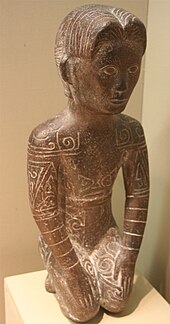
A bronze statue of a seated man, from the State of Yue, Warring States menstruation
King Min of Qi came to exist highly influenced by Lord Mengchang, a grandson of the old King Wei of Qi. Lord Mengchang made a west alliance with the states of Wei and Han. In the far west, Qin, which had been weakened past a succession struggle in 307, yielded to the new coalition and appointed Lord Mengchang its chief minister. The alliance between Qin and Qi was sealed by a Qin princess marrying King Min.[four] This "horizontal" or east-west alliance might have secured peace except that information technology excluded the State of Zhao.
Effectually 299 BC, the ruler of Zhao became the last of the seven major states to proclaim himself "king".
In 298 BC Zhao offered Qin an alliance and Lord Mengchang was driven out of Qin. The remaining three allies, Qi, Wei and Han, attacked Qin, driving up the Yellow River below Shanxi to the Hangu Pass. Subsequently iii years of fighting they took the laissez passer and forced Qin to return territory to Han and Wei. They next inflicted major defeats on Yan and Chu. During the 5-yr administration of Lord Mengchang, Qi was the major ability in People's republic of china.
In 294 BC Lord Mengchang was implicated in a coup d'état and fled to Wei. His alliance system collapsed. Qi and Qin made a truce and pursued their own interests. Qi moved south confronting the State of Song whilst the Qin Full general Bai Qi pushed back eastward against a Han/Wei alliance, gaining victory at the Battle of Yique.
In 288 BC Rex Zhao of Qin and Rex Min of Qi took the championship "Di", (帝 literally emperor), of the west and east respectively. They swore a covenant and started planning an attack on Zhao.
Su Dai and the second vertical alliance [edit]
In 287 BC Su Dai, the younger brother of Su Qin[8] and possibly an amanuensis of Yan, persuaded King Min that the Zhao war would only benefit Qin. Rex Min agreed and formed a 'vertical' alliance with the other states against Qin. Qin backed off, abandoned the presumptuous title of "Di", and restored territory to Wei and Zhao. In 286 Qi annexed the state of Vocal.
The 2d horizontal alliance [edit]
In 285 BC the success of Qi had frightened the other states. Under the leadership of Lord Mengchang, who was exiled in Wei, Qin, Zhao, Wei and Yan formed an alliance. Yan had normally been a relatively weak marry of Qi and Qi feared fiddling from this quarter. Yan'south onslaught under general Yue Yi came every bit a devastating surprise. Simultaneously, the other allies attacked from the due west. Chu declared itself an ally of Qi but contented itself with annexing some territory to its n. Qi'south armies were destroyed while the territory of Qi was reduced to the two cities of Ju and Jimo. King Min himself was later captured and executed past his ain followers.
King Min was succeeded by King Xiang in 283 BC. His general Tian Dan was eventually able to restore much of Qi's territory, but it never regained the influence it had under King Min.
Qin-Zhao war (278–257 BC) [edit]
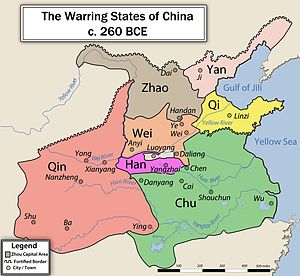
7 Warring States late in the period
Qin has expanded southwest, Chu north and Zhao northwest
General Bai Qi of Qin attacked from Qin'due south new territory (from 316) in Sichuan to the due west of Chu. The capital of Ying was captured and Chu's western lands on the Han River were lost. The effect was to shift Chu significantly to the east.
After Chu was defeated in 278, the remaining swell powers were Qin in the due west and Zhao in the due north-center. In that location was picayune room for diplomatic maneuver and matters were decided by war in 265–260. Zhao had been much strengthened by King Wuling of Zhao (325–299). In 307 he enlarged his cavalry by copying the northern nomads. In 306 he took more land in the northern Shanxi plateau. In 305 he defeated the north-eastern border state of Zhongshan. In 304 he pushed far to the north-west and occupied the eastward-west section of the Yellowish River in the north of the Ordos Loop. Male monarch Huiwen of Zhao (298–266) chose able servants and expanded against the weakened Qi and Wei. In 296 his general Lian Po defeated 2 Qin armies.
In 269 BC Fan Sui became chief advisor to Qin. He advocated disciplinarian reforms, irrevocable expansion and an brotherhood with afar states to set on nearby states (the twenty-third of the Thirty-Vi Stratagems). His maxim "attack not only the territory, but besides the people" enunciated a policy of mass slaughter that became increasingly frequent.[ citation needed ]
In 265 King Zhaoxiang of Qin made the first move by attacking the weak state of Han which held the Yellow River gateway into Qin. He moved north-eastward across Wei territory to cut off the Han exclave of Shangdang due north of Luoyang and due south of Zhao. The Han king agreed to surrender Shangdang, simply the local governor refused and presented it to King Xiaocheng of Zhao. Zhao sent out Lian Po who based his armies at Changping and Qin sent out general Wang He. Lian Po was too wise to risk a decisive boxing with the Qin army and remained within his fortifications. Qin could not break through and the armies were locked in stalemate for three years. The Zhao king decided that Lian Po was not aggressive enough and sent out Zhao Kuo who promised a decisive battle. At the same fourth dimension Qin secretly replaced Wang He with the notoriously violent Bai Qi. When Zhao Kuo left his fortifications, Bai Qi used a Cannae maneuver, falling back in the eye and surrounding the Zhao army from the sides. After being surrounded for 46 days, the starving Zhao troops surrendered in September 260 BC. It is said that Bai Qi had all the prisoners killed and that Zhao lost 400,000 men.
Qin was as well exhausted to follow upwardly its victory. Some time later information technology sent an regular army to besiege the Zhao capital simply the army was destroyed when it was attacked from the rear. Zhao survived, only there was no longer a state that could resist Qin on its ain. The other states could have survived if they remained united against Qin, but they did not.
In 257 BC, Qin army failed to besiege Handan and was defeated past the centrolineal force of Zhao, Wei and Chu during the Battle of Handan.
End of Zhou dynasty (256–249 BC) [edit]
The forces of King Zhao of Qin defeated King Nan of Zhou and conquered West Zhou in 256 BC, claiming the Nine Cauldrons and thereby symbolically becoming The Son of Heaven.
King Zhao's exceptionally long reign concluded in 251 BC. His son King Xiaowen, already an quondam homo, died just 3 days afterward his coronation and was succeeded by his son King Zhuangxiang of Qin. The new Qin king proceeded to conquer East Zhou, vii years after the autumn of West Zhou. Thus the 800-year Zhou dynasty, nominally Mainland china'due south longest-ruling regime, finally came to an end.[6]
Sima Qian contradicts himself regarding the ultimate fate of the East Zhou court. Chapter 4 (The Annals of Zhou) concludes with the sentence "thus the sacrifices of Zhou ended", just in the following chapter 5 (The Annals of Qin) we learn that "Qin did not prohibit their sacrifices; the Lord of Zhou was allotted a patch of country in Yangren where he could continue his ancestral sacrifices".
Qin unites Mainland china (247–221 BC) [edit]
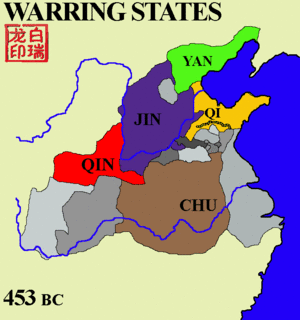
Animated map of the Warring States period[nine]
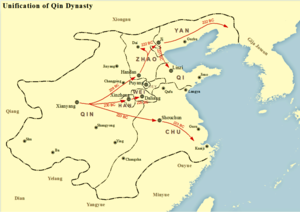
Unification of Qin from 230 BC to 211 BC
Rex Zhuangxiang of Qin ruled for only iii years. He was succeeded by his son Zheng, who unlike the two elderly kings that preceded him was simply xiii years old at his coronation. As an adult Zheng would turn out to be a brilliant commander who, in the span of merely ix years, unified China.[seven]
Conquest of Han [edit]
In 230 BC, Qin conquered Han.[10] Han, the weakest of the 7 Warring States, was side by side to the much stronger Qin, and had suffered continuous assaults past Qin in earlier years of the Warring States period. This went on until Emperor Qin Shi Huang sent general Wang Jian to attack Zhao. Rex An of Han, frightened past the thought that Han would be the side by side target of the Qin state, immediately sent diplomats to surrender the entire kingdom without a fight, saving the Han populace from the terrible potential consequences of an unsuccessful resistance.
Conquest of Wei [edit]
In 225 BC, Qin conquered Wei. The Qin army led a direct invasion into Wei by besieging its uppercase Daliang only before long realized that the city walls were also tough to pause into. They devised a new strategy in which they utilized the power of a local river that was linked to the Yellow River. The river was used to flood the urban center's walls, causing massive devastation to the metropolis. Upon realizing the situation, Rex Jia of Wei hurriedly came out of the capital and surrendered it to the Qin army in order to avoid further bloodshed of his people.
Conquest of Chu [edit]

In 223 BC, Qin conquered Chu. The first invasion was however an utter disaster when 200,000 Qin troops, led by the general, Li Xin, were defeated by 500,000 Chu troops in the unfamiliar territory of Huaiyang, modern-mean solar day northern Jiangsu and Anhui provinces. Xiang Yan, the Chu commander, had lured Qin by allowing a few initial victories, but then counterattacked and burnt two large Qin camps.
In 222 BC, Wang Jian was recalled to lead a 2d military invasion with 600,000 men against the Chu state. Loftier in morale after their victory in the previous year, the Chu forces were content to sit back and defend confronting what they expected to exist a siege of Chu. However, Wang Jian decided to weaken Chu'due south resolve and tricked the Chu army by actualization to be idle in his fortifications whilst secretly training his troops to fight in Chu territory. After a year, the Chu defenders decided to disband due to apparent lack of activeness from the Qin. Wang Jian invaded at that indicate, with full forcefulness, and overran Huaiyang and the remaining Chu forces. Chu lost the initiative and could simply sustain local guerrilla-style resistance until it too was fully conquered with the devastation of Shouchun and the decease of its final leader, Lord Changping, in 223 BC. At their peak, the combined armies of Chu and Qin are estimated to have ranged from hundreds of thousands to a one thousand thousand soldiers, more than those involved in the campaign of Changping between Qin and Zhao 35 years earlier.[11]
Conquest of Zhao and Yan [edit]
In 222 BC, Qin conquered Zhao and Yan. After the conquest of Zhao, the Qin army turned its attention towards Yan. Realizing the danger and gravity of this situation, Crown Prince Dan of Yan had sent Jing Ke to assassinate King Zheng of Qin, but this failure just helped to fuel the rage and determination of the Qin male monarch, and he increased the number of troops to conquer the Yan country.
Conquest of Qi [edit]
In 221 BC, Qin conquered Qi. Qi was the final unconquered warring state. Information technology had not previously contributed or helped other states when Qin was conquering them. Every bit soon every bit Qin's intention to invade information technology became clear, Qi swiftly surrendered all its cities, completing the unification of China and ushering in the Qin dynasty. The last Qi male monarch lived out his days in exile in Gong and was not given a posthumous name later decease, therefore he is known to posterity by his personal proper name Jian.
The Qin king Ying Zheng declared himself as Qin Shi Huangdi, "The first Sovereign Emperor of Qin".[x]
In the rule of the Qin state, the union was based solely on military power. The feudal holdings were abolished, and noble families were forced to live in the capital letter city Xianyang, in guild to be supervised. A national road likewise as greater use of canals was used in order for deployment and supply of the ground forces to be done with ease and speed. The peasants were given a wider range of rights in regards of land, although they were discipline to taxation, creating a large corporeality of acquirement to the state.[x]
Military theory and practice [edit]
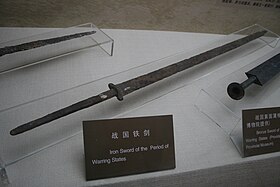
An iron sword of the Warring States.


Model of a Warring States menstruation traction trebuchet.
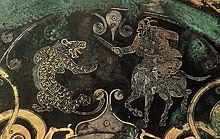
A horse-rider fighting a tiger, depicted on a gilded mirror discovered in Jincun, Luoyang.
Increasing calibration of warfare [edit]
The chariot remained a major cistron in Chinese warfare long after it went out of fashion in the Middle Eastward. Nigh the offset of the Warring States menstruation there is a shift from chariots to massed infantry, possibly associated with the invention of the crossbow. This had two major effects. Get-go information technology led the dukes to weaken their chariot-riding nobility and so they could get direct access to the peasantry who could be drafted as infantry. This change was associated with the shift from aristocratic to bureaucratic regime. 2d, information technology led to a massive increase in the calibration of warfare. When the Zhou overthrew the Shang at the Battle of Muye they used 45,000 troops and 300 chariots. For the Warring States period the post-obit figures for the war machine strengths of diverse states are reported:
- Qin
1,000,000 infantry, one,000 chariots, 10,000 horses; - Chu
same numbers; - Wei
200–360,000 infantry, 200,000 spearmen, 100,000 servants, 600 chariots, 5,000 cavalry; - Han
300,000 full; - Qi
several hundred thousand;
For major battles, the post-obit figures are reported:
- Battle of Maling
100,000 killed; - Battle of Yique
240,000 killed; - General Bai Qi is said to accept been responsible for 890,000 enemy deaths over his career.
Many scholars retrieve these numbers are exaggerated (records are inadequate, they are much larger than those from similar societies, soldiers were paid by the number of enemies they killed and the Han dynasty had an involvement in exaggerating the bloodiness of the historic period before People's republic of china was unified). Regardless of exaggeration, it seems clear that warfare had become excessive during this period. The bloodshed and misery of the Warring States period goes a long mode in explaining Cathay'due south traditional and current preference for a united throne.[12]
Military developments [edit]

Warring States swords and spearhead with patterns
The Warring States period saw the introduction of many innovations to the art of warfare in China, such as the use of atomic number 26 and of cavalry.
Warfare in the Warring States period evolved considerably from the Jump and Fall menses, as most armies fabricated use of infantry and cavalry in battles, and the use of chariots became less widespread. The use of massed infantry fabricated warfare bloodier and reduced the importance of the elite, which in turn fabricated the kings more despotic. From this menstruum onward, as the various states competed with each other past mobilizing their armies to war, nobles in Communist china belonged to the literate class, rather than to the warrior class every bit had previously been the case.
The various states fielded massive armies of infantry, cavalry, and chariots. Complex logistical systems maintained by efficient authorities bureaucracies were needed to supply, train, and control such big forces. The size of the armies ranged from tens of thousands to several hundred chiliad men.[thirteen] Iron weapons became more than widespread and began to replace bronze. Most armour and weapons of this period were made from iron.
The beginning official native Chinese cavalry unit was formed in 307 BC during the military reforms of King Wuling of Zhao, who advocated 'nomadic apparel and horse archery'.[fourteen] Only the war chariot still retained its prestige and importance, despite the tactical superiority of cavalry.
The crossbow was the preferred long-range weapon of this period, due to several reasons. The crossbow could be mass-produced easily, and mass training of crossbowmen was possible. These qualities fabricated it a powerful weapon against the enemy.
Infantrymen deployed a diversity of weapons, but the most popular was the dagger-axe. The dagger-axe came in diverse lengths, from 9 to 18 anxiety; the weapon consisted of a thrusting spear with a slashing blade appended to it. Dagger-axes were an extremely pop weapon in various kingdoms, especially for the Qin, who produced xviii-foot-long thruway-similar weapons.
Military thought [edit]
The Warring States was a cracking period for military strategy; of the Seven Military Classics of China, four were written during this period:
- The Art of War
It is attributed to Sun Tzu, a highly influential report of strategy and tactics.[15] - Wuzi
Information technology is attributed to Wu Qi, a statesman and commander who served the states of Wei and so Chu. - Wei Liaozi
of uncertain authorship. - The Methods of the Sima
Information technology is attributed to Sima Rangju, a commander serving the state of Qi.
Civilisation and lodge [edit]

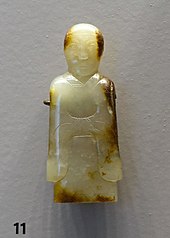

The Warring States period was an era of warfare in ancient Communist china, equally well as bureaucratic and military reforms and consolidation; the major states, ruling over large territories, quickly sought to consolidate their powers, leading to the final erosion of the Zhou courtroom's prestige. As a sign of this shift, the rulers of all the major states (except for Chu, which had claimed kingly title much earlier) abandoned their former feudal titles for the title of 王, or Rex, challenge equality with the rulers of the Zhou.
At the same time, the constant conflict and need for innovative social and political models led to the development of many philosophical doctrines, later known as the Hundred Schools of Thought. The well-nigh notable schools of idea include Mohism (expounded by Mozi), Confucianism (represented past Mencius and Xunzi), Legalism (represented by Shang Yang, Shen Buhai, Shen Dao and Han Fei) and Taoism (represented by Zhuangzi and Lao Tzu).
The many states that were competing between each other attempted to brandish their power not only militarily merely in their courts and country philosophy. Many differing rulers adopted the differing philosophies in their own reward or that of their kingdom.
Mencius attempted to instate Confucianism equally a state philosophy through proposing that through the governing of moral principles like benevolence and righteousness, the state would win popular support from one country and those neighboring, eliminating the need of a war altogether. Mencius had attempted to convince King Hui of Liang, although was unsuccessful since the king saw no advantage in the period of wars.[16]
Mohism was developed by Mozi (468–376 BC) and it provided a unified moral and political philosophy based on impartiality and benevolence.[17] Mohists had the belief that people alter depending on environments around. The same was practical to rulers, which is why one must exist cautious of foreign influences. Mozi was very much against warfare, although he was a swell tactician in defence force. He defended the small land of Song from many attempts of the Chu state.[18]
Taoism was advocated by Laozi, and believed that human nature was adept and can accomplish perfection past returning to original state. It believed that like a baby, humans are unproblematic and innocent although with evolution of civilizations it lost its innocence only to be replaced past fraud and greed. Contrarily to other schools, it did not desire to gain influence in the offices of states and Laozi even refused to exist in the minister of the country of Chu.[xviii]
Legalism created by Shang Yang in 338 BC, rejected all notions of faith and practices, and believed a nation should be governed past strict law. Not only were severe punishments applied, but they would exist grouped with the families and made mutually responsible for criminal human action. It proposed radical reforms, and established a guild based on solid ranks. Peasants were encouraged to exercise agriculture as occupation, and military machine performance was rewarded. Laws were also applied to all ranks with no exception; even the king was not above punishment. The philosophy was adapted by the Qin state and it created it into a well-organized, centralized state with a bureaucracy chosen on the basis of merit.[sixteen] This menstruum is most famous for the establishment of complex bureaucracies and centralized governments, equally well as a clearly established legal system. The developments in political and military organization were the basis of the power of the Qin state, which conquered the other states and unified them nether the Qin Empire in 221 BC.
Nobles, bureaucrats and reformers [edit]
The phenomenon of intensive warfare, based on mass formations of infantry rather than the traditional chariots, was i major tendency which led to the creation of potent fundamental bureaucracies in each of the major states. At the same time, the process of secondary feudalism which permeated the Bound and Autumn catamenia, and led to such events as the partition of Jin and the usurpation of Qi by the Tian clan, was somewhen reversed by the same process of bureaucratisation.
Nether the demands of warfare, the states adopted bureaucratic reforms in the Warring States period. Wei adopted these in 445 BC, Zhao in 403 BC, Chu in 390 BC, Han in 355 BC, Qi in 357 BC and Qin in 350 BC. Power was centralised by curbing the landed aristocrats and sinecures and creating a new bureaucracy based on meritorious service to the state, which were drawn from the lower rungs of gild. Systematic auditing and reporting systems, and stock-still salaries for officials were created.[19]
The reforms of Shang Yang in Qin, and of Wu Qi in Chu, both centred on increased centralisation, the suppression of the dignity, and a vastly increased telescopic of regime based on Legalist ethics, which were necessary to mobilise the large armies of the period.[ citation needed ]
Sophisticated arithmetic [edit]

A bundle of 21 bamboo slips from the Tsinghua collection dated to 305BC are the globe's earliest example of a two digit decimal multiplication tabular array, indicating that sophisticated commercial arithmetic was already established during this period.[20]
Rod numerals were used to correspond both negative and positive integers, and rational numbers, a truthful positional number system, with a bare for zero[21] dating back to the Warring States period.
Literature [edit]
An important literary accomplishment of the Warring States period is the Zuo Commentary on the Jump and Fall Annals, which summarizes the preceding Spring and Autumn period. The less famous work Guoyu is thought to exist by the same writer.
Many sayings of Bound and Autumn philosophers, which had previously been circulated orally, were put into writing in the Warring States. These include the Analects and The Art of War.
Economic developments [edit]
The Warring States period saw the proliferation of iron working in Red china, replacing statuary every bit the dominant blazon of metal used in warfare. Areas such as Shu (present-24-hour interval Sichuan) and Yue (present-day Zhejiang) were also brought into the Chinese cultural sphere during this time. Merchandise also became important, and some merchants had considerable power in politics, the nigh prominent of which was Lü Buwei, who rose to become Chancellor of Qin and was a fundamental supporter of the eventual Qin Shihuang.[ commendation needed ]
At the same time, the increased resources of consolidated, bureaucratic states, coupled with the logistical needs of mass levies and big-scale warfare, led to the proliferation of economic projects such every bit large-scale waterworks. Major examples of such waterworks include the Dujiangyan Irrigation Organization, which controlled the Min River in Sichuan and turned the former backwater region into a major Qin logistical base, and the Zhengguo Canal which irrigated large areas of land in the Guanzhong Plainly, over again increasing Qin's farm production.
Run into likewise [edit]
- Sengoku menstruation – A period in Japanese history named after this period
- Iii Kingdoms
- Warlord Era
References [edit]
Citations [edit]
- ^ Cartwright, Mark (July 12, 2017). "Warring States Flow". World History Encyclopedia.
- ^ Melt, Scott (2010). ""San De" and Warring States Views on Heavenly Retribution". Journal of Chinese Philosophy. 37: 101–123. doi:ten.1111/j.1540-6253.2010.01622.10.
- ^ a b c d Shi Ji, chapter xv
- ^ a b c Shi Ji, chapter 46
- ^ Shi Ji, affiliate xvi
- ^ a b c d e Shi Ji, chapter 4
- ^ a b Shi Ji, affiliate 5
- ^ a b Shi Ji, affiliate 69
- ^ "MDBG", Sökord: 战国策
- ^ a b c Cotterell (2010), pp. xc–91.
- ^ Lewis (1999), pp. 626–629.
- ^ Loewe, Michael; Shaughnessy, Edward L. (1999). The Cambridge History of Ancient Red china. p. 625.
- ^ Ebrey, Walthall & Palais (2006), p. ?[ page needed ]
- ^ Ebrey, Walthall & Palais (2006), p. 29.
- ^ Tzu & Griffith (1963), p. v.
- ^ a b Haw, Stephen Thou. (2008). A traveller's history of China. Canada: Interlink Books. pp. 64–71.
- ^ Fraser, Chris (1 January 2015). "Mohism". The Stanford Encyclopedia of Philosophy. Metaphysics Research Lab, Stanford University. Retrieved 17 March 2017.
- ^ a b Lu & Ke (2012).
- ^ Edgar Kiser; Yong Cai (Aug 2003). "War and Bureaucratization in Qin China: Exploring an Anomalous Case". American Sociological Review. 68 (4): 527–528.
- ^ Qiu, Jane (seven January 2014). "Aboriginal times table subconscious in Chinese bamboo strips: The 2,300-year-one-time matrix is the world's oldest decimal multiplication table". Nature. doi:10.1038/nature.2014.14482. S2CID 130132289.
- ^ Unicodes 1D360—1D37F : Counting Rod Numerals
Sources [edit]
- Cotterell, Arthur (2010), Asia, a Curtailed History, Singapore: John Wiley & Sons, ISBN978-0-470-82959-2.
- Ebrey, Patricia Buckley; Walthall, Anne; Palais, James B. (2006), Pre-Modernistic Eastward Asia: A Cultural, Social, and Political History, Boston, MA: Houghton-Mifflin Visitor, ISBN0-618-13386-0.
- Lewis, Mark Edward (1999), "Warring States Political History", in Loewe, Michael; Shaughnessy, Edward 50. (eds.), The Cambridge history of ancient People's republic of china: from the origins of civilisation to 221 B.C., Cambridge Academy Press, pp. 587–649, ISBN978-0-521-47030-8.
- Lu, Liqing; Ke, Jinhua (2012), "A Curtailed History of Chinese Psychology of Religion", Pastoral Psychology, 61 (5–6): 623–639, doi:10.1007/s11089-011-0395-y, S2CID 144556354.
- Tzu, Dominicus; Griffith, Samuel B. (1963), The Fine art of War, New York, NY: Oxford University Press
Further reading [edit]
- Li Xueqin (1985). Eastern Zhou and Qin Civilizations. Translated by Chang, Yard.C. New Haven: Yale University Printing. ISBN0-300-03286-2.
- Yap, Joseph P. (2009). Wars with the Xiongnu: A Translation from Zizhi Tongjian . Bloomington, Indiana, U.S.A.: AuthorHouse. ISBN978-i-4490-0604-iv.
- Sima Guang (2016). Zizhi Tongjian: Warring States and Qin. Vol. 1 to 8 - 403-207 BCE. Translated by Yap, Joseph P. CreateSpace. ISBN978-1533086938. LCCN 2016908788.
External links [edit]
- Warring States Menstruum - World History Encyclopedia
- Warring States Project, University of Massachusetts Amherst
- Rulers of the warring states – Chinese Text Project
- China's Warring States Menses, BBC Radio 4 discussion with Chris Cullen, Vivienne Lo & Carol Michaelson (In Our Time, Apr. 1, 2004)
Source: https://en.wikipedia.org/wiki/Warring_States_period

0 Response to "What Is a Piece of Art From the Shang Period"
Post a Comment